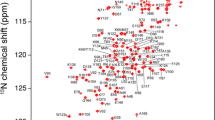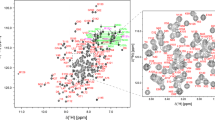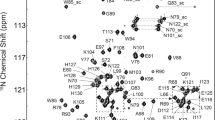Abstract
Bacterial cells often use two-component signal transduction systems to regulate genes in response to environmental stimuli. The RstA/RstB system is a two-component regulatory system consisting of the membrane sensor, RstB, and its cognate response regulator RstA. The RstA of Klebsiella pneumoniae consists of a N-terminal receiver domain (NRD, residues 1-119) and a C-terminal DNA-binding domain (DBD, residues 130-236). Phosphorylation of the response regulator induces a conformational change in the regulatory domain of RstA, which results in activation of the effector domain to regulate the downstream genes, including the ferrous iron transport system (Feo), at low-pH condition. Here we report the 1H, 13C and 15N resonance assignments and secondary structure identification of the DBD of RstA from K. pneumoniae as a first step for unraveling the structural and functional relationship of the RstA/RstB two component system.


Similar content being viewed by others
References
Cabeza ML, Aguirre A, Soncini FC, Vescovi EG (2007) Induction of RpoS degradation by the two-component system regulator RstA in Salmonella enterica. J Bacteriol 189:7335–7342
del Castillo-Rueda A, Khosravi-Shahi P (2010) The role of iron in the interaction between host and pathogen. Med Clin (Barc) 134:452–456
Jeon J, Kim H, Yun J, Ryu S, Groisman EA, Shin D (2008) RstA-promoted expression of the ferrous iron transporter FeoB under iron-replete conditions enhances fur activity in Salmonella enterica. J Bacteriol 190:7326–7334
Mao X-M, Zhou Z, Cheng L-Y, Hou X-P, Guan W-J, Li Y-Q (2009) Involvement of SigT and RstA in the differentiation of Streptomyces coelicolor. FEBS Lett 583:3145–3150
Markley JL, Bax A, Arata Y, Hilbers CW, Kaptein R, Sykes BD, Wright PE, Wuthrich K (1998) Recommendations for the presentation of NMR structures of proteins and nucleic acids. IUPAC-IUBMB-IUPAB Inter-Union Task Group on the standardization of data bases of protein and nucleic acid structures determined by NMR spectroscopy. J Biomol NMR 12:1–23
Martinez-Hackert E, Stock AM (1997) The DNA-binding domain of OmpR: crystal structures of a winged helix transcription factor. Structure 5:109–124
Mizuno T, Tanaka I (1997) Structure of the DNA-binding domain of the OmpR family of response regulators. Mol Microbiol 24:665–667
Nam D, Choi E, Kweon D-H, Shin D (2010) The RstB sensor acts on the PhoQ sensor to control expression of PhoP-regulated genes. Mol Cells 30:363–368
Ogasawara H, Hasegawa A, Kanda E, Miki T, Yamamoto K, Ishihama A (2007) Genomic SELEX search for target promoters under the control of the PhoQP-RstBA signal relay cascade. J Bacteriol 189:4791–4799
Rhee JE, Sheng W, Morgan LK, Nolet R, Liao X, Kenney LJ (2008) Amino acids important for DNA recognition by the response regulator OmpR. J Biol Chem 283:8664–8677
Whitworth DE, Cock PJA (2009) Evolution of prokaryotic two-component systems: insights from comparative genomics. Amino Acids 37:459–466
Wishart DS, Sykes BD (1994) Chemical shifts as a tool for structural determination. Methods Enzymol 239:363–392
Yamamoto K (2004) Functional characterization in vitro of all two-component signal transduction systems from Escherichia coli. J Biol Chem 280:1448–1456
Acknowledgments
The NMR spectra were obtained at High-Field Nuclear Magnetic Resonance Center (HF-NMRC) supported by the National Research Program for Genomic Medicine. This work was supported by a grant from the National Science Council of the Republic of China (NSC 100-2311-B-001-023).
Author information
Authors and Affiliations
Corresponding author
Rights and permissions
About this article
Cite this article
Chen, SC., Chang, CF., Fan, PJ. et al. 1H, 13C and 15N resonance assignments of the C-terminal DNA-binding domain of RstA protein from Klebsiella pneumoniae . Biomol NMR Assign 7, 85–88 (2013). https://doi.org/10.1007/s12104-012-9383-0
Received:
Accepted:
Published:
Issue Date:
DOI: https://doi.org/10.1007/s12104-012-9383-0




